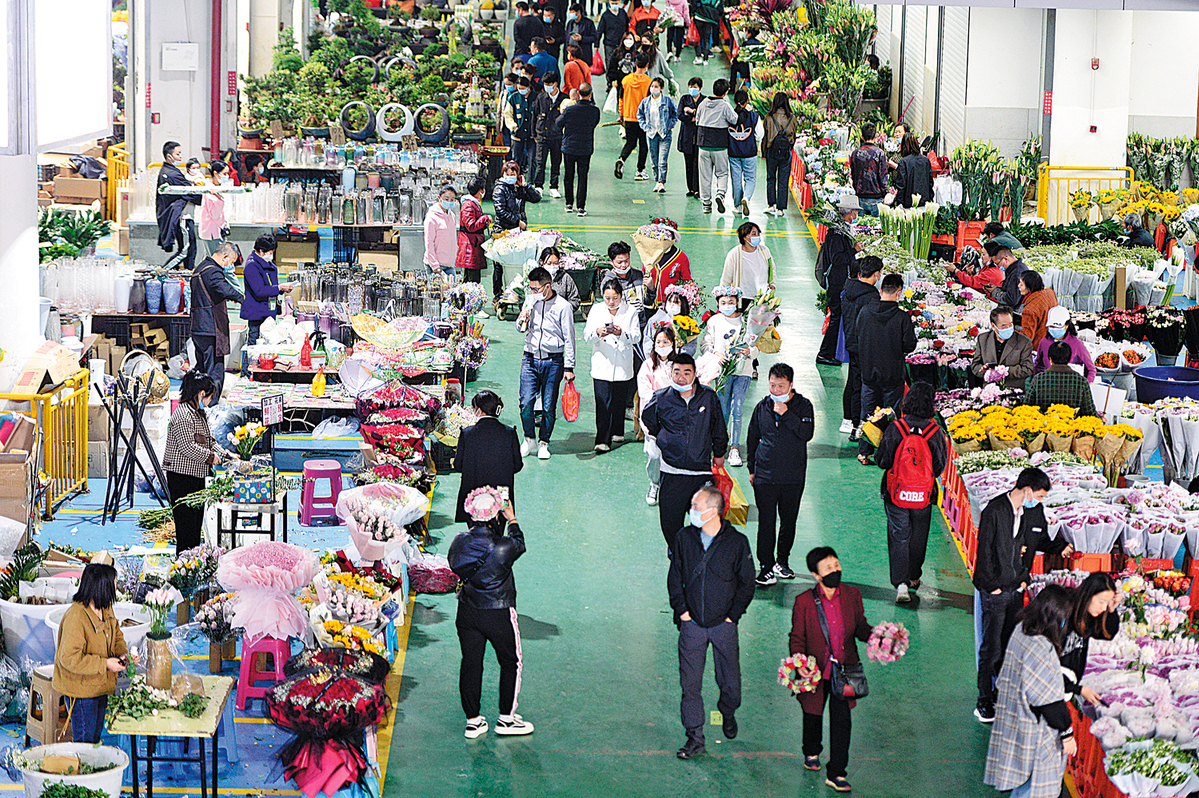Flower industry blooming despite recent COVID hurdles
Bouquet sales grow on events like 520, Mother's Day
By ZHU WENQIAN in Beijing and LI YINGQING in Kunming | CHINA DAILY | Updated: 2022-06-03 07:29

Bouquet sales grow on events like 520, Mother's Day
Despite the recent resurgence of local COVID-19 cases, demand for fresh flowers continues to remain high, and e-commerce platforms have helped boost flower consumption nationwide.
Sales of flowers, especially roses, saw a peak on May 20, as the pronunciation of"520" sounds similar to "I love you" in Chinese, and the day has become an unofficial second Valentine's Day celebrated in China. Flowers saw good yields and lower prices for May 20 compared with Valentine's Day on Feb 14, insiders observed.
"The supply volume of flowers for May 20 this year was quite large. Red roses carried lower price tags compared with roses in other colors. May 15 and 16 served as the peak period of flower preparation for May 20," said Wang Shouhai, manager of the auction department at Kunming Dounan Agricultural Products Auction Co Ltd, a company located in Southwest China's Yunnan province.
Demand for flowers for Mother's Day, which fell on May 8 this year, grew more than 50 percent year-on-year, according to Huaeb.com, a domestic flower wholesale e-commerce trading platform.
In the 10 days before Mother's Day, Huaeb.com saw its total transaction value exceed 40 million yuan ($6 million). During the period, the transaction volume reached 42 million units of flowers, which was higher than the volume seen in the same period last year, according to the platform.
"Flowers have increasingly become an important consumer goods for households in China, and the market boasts a remarkable growth potential," said Zuo Youlun, operation director of Huaeb.com.
Still, due to regional outbreaks of COVID-19 recently, prices of flowers declined slightly compared to the same period in the past few years. For instance, carnations, a symbolic flower for Mother's Day, saw prices drop 20 percent year-on-year. Pink carnations have seen about 50 percent higher sales volume than red carnations, Huaeb.com found.
Roses, sunflowers, eustoma and lilies also serve as the main flowers to celebrate Mother's Day, and popular colors include pink, red, yellow and orange. Sunflowers saw prices remain flat, and the average prices of eustoma and roses fell 30 percent and 10 percent year-on-year, respectively, according to the platform.
Peng Guotai, a fresh flower florist at Kunming Dounan Flower Market, the largest fresh-cut flower trading market in Asia, said most of his flowers are sold to Beijing, Shanghai and Inner Mongolia.
"Sales of flowers during the period around Mother's Day were quite good, and demand from different regions nationwide was high. Considering the pandemic, wholesalers and flower stores didn't prepare sufficient stocks, and the supply fell short of demand in some places," Peng said.
Despite the pandemic, in the past two years, the business performance of the fresh flower sector in China has been rosy and unprecedented in the past 40 years, said Zhang Li, deputy director of the Market Circulation Branch of the China Flower Association.
In 2021, Freshippo, the grocery chain of Alibaba Group, began making more efforts to develop its flower business. The company has established its own processing center and directly connects its business with flower production bases, and thus it can provide better prices to consumers.
Freshippo said it keeps the transportation trucks for flowers below 15 C and spot-checks the quality of 30 percent of its flowers. For roses, it checks on the glossiness of the flowers, if there is any physical damage during processing and if there are any pests or pesticide residue.
Online food delivery service providers such as Meituan and Ele.me have also launched flower delivery businesses. They cooperate with physical flower stores and help deliver flowers to customers, and most flower delivery demand occurs during holidays.
Last year, 70 percent of fresh flowers available in the market nationwide originated from Yunnan, according to data from Kunming Customs.
But most demand for flowers comes from major cities such as Beijing, Shanghai, Guangzhou and Shenzhen in Guangdong province, and consumers from those cities frequently buy flowers through e-commerce sites.
Thus, long-term and long-distance transportation remain the main challenges for flower sales, as the preservation time of flowers is short, according to a research report by consultancy iiMedia Research.
Contact the writers at zhuwenqian@chinadaily.com.cn
























